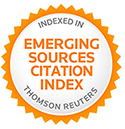Algoritmo basado en Q-learning para el aprendizaje de las dificultades de los niños en las tablas de multiplicar
Resumen
Para ayudar a los niños con sus dificultades con las tablas de multiplicar, este artículo presenta un sistema de aprendizaje basado en el algoritmo Q-learning, que permite a los agentes de software aprender qué tablas de multiplicar son difíciles para un niño. Los resultados indican que nuestro sistema de aprendizaje es eficaz para aprender los niveles de dificultad de los niños (bajo, medio, alto y muy alto) en las tablas de multiplicar, cuando un agente pregunta aleatoriamente todas las operaciones de las tablas de multiplicar (64 operaciones, del 2 al 9). Además, nuestro sistema de aprendizaje permite saber qué tablas de multiplicar presentan mayor dificultad con respecto a las demás, tras preguntar al menos una operación por cada tabla.
Recibido: 28 de diciembre de 2024
Aceptado: 22 de marzo de 2025
Palabras clave
Texto completo:
PDF (English)Referencias
Aguilar, J. (2014). Introducción a los Sistemas Emergentes. Talleres Gráficos, Universidad de Los Andes: Venezuela. Axelsson, A., Anderberg, E., & Haake, M. (2013). Can Preschoolers Profit from a Teachable Agent Based Play-and-Learn Game in Mathematics? In Lecture notes in computer science (pp. 289–
. https://doi.org/10.1007/978-3-642-39112-5_30
Belpaeme, T., Kennedy, J., Ramachandran, A., Scassellati, B., & Tanaka, F. (2018). Social robots for education: A review. Science Robotics, 3(21).
https://doi.org/10.1126/scirobotics.aat5954
Brown, L., & Howard, A. (2014). The positive effects of verbal encouragement in mathematics education using a social robot. In 2014 IEEE integrated STEM education conference (pp. 1-5). http://doi.org/10.1109/ISECon.2014.6891009
Castro-González, Á., Malfaz, M., & Salichs, M. A. (2011). Learning the selection of actions for an autonomous social robot by reinforcement learning based on motivations. International Journal of Social Robotics, 3(4), 427–441. https://doi.org/10.1007/s12369-011-0113-z
Jang, B., Kim, M., Harerimana, G., & Kim, J. W. (2019). Q-Learning Algorithms: A Comprehensive Classification and applications. IEEE Access, 7, 133653–133667. https://doi.org/10.1109/access.2019.2941229
Kim, Y., Thayne, J., & Wei, Q. (2016). An embodied agent helps anxious students in mathematics learning. Educational Technology Research and Development, 65(1), 219–235. https://doi.org/10.1007/s11423-016-9476-z
Liles, K. R. (2019). Ms. An (Meeting Students’ Academic Needs): Engaging Students in Math Education. Lecture Notes in Computer Science, 645–661. https://doi.org/10.1007/978-3-030-22341-0_50
Michaelis, J. & Mutlu, B. (2019). Supporting interest in science learning with a social robot. In Proceedings of the 18th ACM international
conference on interaction design and children (pp. 71-82). https://doi.org/10.1145/3311927.3323154
Mohammadhasani, N., Fardanesh, H., Hatami, J., Mozayani, N., & Fabio, R. A. (2018). The pedagogical agent enhances mathematics learning in ADHD students. Education and Information Technologies, 23(6), 2299–2308. https://doi.org/10.1007/s10639-018-9710-x
Park, H. W., Grover, I., Spaulding, S., Gomez, L., & Breazeal, C. (2019). A Model-Free affectivereinforcement learning approach to personalization of an autonomous social robot companion for early literacy education. Proceedings of the AAAI Conference on Artificial Intelligence, 33(01), 687–694.
https://doi.org/10.1609/aaai.v33i01.3301687
Pareto, L. (2014). A teachable agent game engaging primary school children to learn arithmetic concepts and reasoning. International Journal of
Artificial Intelligence in Education, 24(3), 251–283. https://doi.org/10.1007/s40593-014-0018-8
Pérez, J., Aguilar, J., & Dapena, E. (2020). MIHR: a Human-Robot Interaction Model. IEEE Latin America Transactions, 18(09), 1521–1529. https://doi.org/10.1109/tla.2020.9381793
Pérez, J., Dapena, E., & Aguilar, J. (2024). Emotions as implicit feedback for adapting difficulty in tutoring systems based on reinforcement
learning. Education and Information Technologies, 29(16), 21015–21043. https://doi.org/10.1007/s10639-024-12699-8
Ramachandran, A., Huang, C. M., & Scassellati, B. (2017). Give me a break! Personalized timing strategies to promote learning in robot-child
tutoring. In Proceedings of the 2017 ACM/IEEE International Conference on Human-Robot Interaction (pp. 146-155). https://ieeexplore.ieee.org/document/8534798
Russell, S. J., & Norvig, P. (2016). Artificial Intelligence: A Modern Approach (3rd ed.).Prentice Hall Press: Upper Saddle River, USA.
Sutton, R. & Barto, A. (2018). Reinforcement Learning: An Introduction. A Bradford Book: USA.
Van Otterlo, M., & Wiering, M. (2012). Reinforcement learning and Markov decision processes. In Adaptation, learning, and optimization (pp. 3–
. https://doi.org/10.1007/978-3-642-27645-3_1
Vlachogiannis, J., & Hatziargyriou, N. (2004). Reinforcement learning for reactive power control. IEEE Transactions on Power Systems,
(3), 1317–1325. https://doi.org/10.1109/tpwrs.2004.831259
Vrochidou, E., Najoua, A., Lytridis, C., Salonidis, M., Ferelis, V., & Papakostas, G. A. (2018). Social robot NAO as a self-regulating didactic
mediator: A case study of teaching/learning numeracy. In 2018 26th international conference on software, telecommunications and computer networks (SoftCOM) (pp. 1-5). https://doi.org/10.23919/softcom.2018.8555764
Watkins, C. J. C. H., & Dayan, P. (1992). Q-learning. Machine Learning, 8(3), 279–292. https://doi.org/10.1007/bf00992698
Zhang, D., Ding, Y., Lee, S., & Chen, J. (2016). Strategic development of multiplication problem solving: Patterns of students’ strategy
choices. The Journal of Educational Research, 110(2), 159–170. https://doi.org/10.1080/00220671.2015.1060928
Zhang, D., Xin, Y. P., Harris, K., & Ding, Y. (2013). Improving multiplication strategic development in children with math difficulties. Learning
Disability Quarterly, 37(1), 15–30. https://doi.org/10.1177/0731948713500146
![]()
Todos los documentos publicados en esta revista se distribuyen bajo una
Licencia Creative Commons Atribución -No Comercial- Compartir Igual 4.0 Internacional.
Por lo que el envío, procesamiento y publicación de artículos en la revista es totalmente gratuito.
 |  |  |




